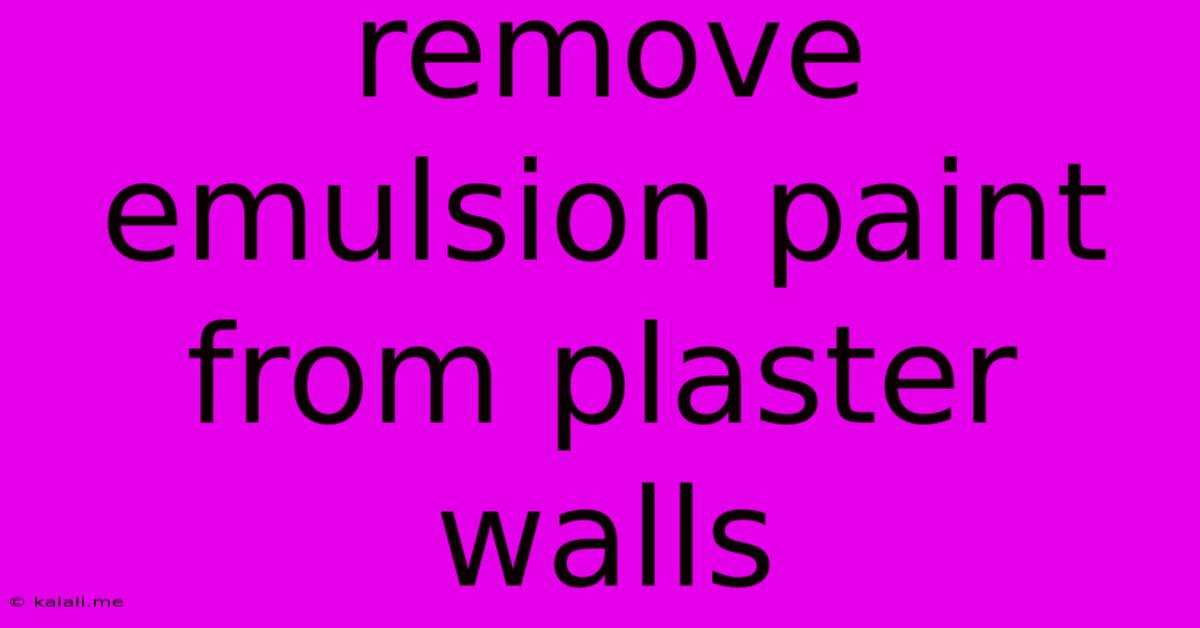Remove Emulsion Paint From Plaster Walls
Kalali
May 22, 2025 · 3 min read

Table of Contents
Removing Emulsion Paint from Plaster Walls: A Comprehensive Guide
Removing emulsion paint from plaster walls can seem daunting, but with the right approach and tools, it's a manageable DIY project. This guide will walk you through the process, covering different techniques and offering advice to achieve the best results. Whether you're preparing for repainting, restoring original features, or simply updating your décor, removing emulsion paint effectively is key.
Understanding Emulsion Paint and Plaster Walls
Emulsion paint, a water-based paint, is commonly used on plaster walls due to its ease of application and relatively quick drying time. However, removing it can be challenging, especially if multiple layers have accumulated over time. Plaster, a porous material, can absorb moisture, complicating the removal process. Understanding these properties is crucial for choosing the right removal method. This guide focuses on safe and effective techniques suitable for homeowners.
Choosing the Right Removal Method: Assessing Your Situation
The best method for removing emulsion paint from plaster walls depends on several factors:
- The amount of paint: A few patches of paint might require a different approach than removing paint from an entire wall.
- The condition of the plaster: If your plaster is fragile or damaged, aggressive methods should be avoided.
- Your time and resources: Some methods are quicker and easier than others.
Here are the primary methods:
1. Scraping: The Quickest Option (For Small Areas and Loose Paint)
For small areas with loose or flaking paint, a scraper can be very effective. Use a paint scraper with a sharp blade, working carefully to avoid damaging the plaster underneath. This method is best for removing only loose paint, and isn't suitable for large areas or heavily adhered paint.
2. Heat Gun: Efficient but Requires Caution (For Larger Areas with Multiple Coats)
A heat gun can soften the paint, making it easier to scrape off. Always wear appropriate safety gear, including gloves and eye protection, as the heat gun can reach high temperatures. Work in small sections, applying heat evenly and scraping immediately. Be mindful not to overheat the plaster, which can cause damage. This method is better suited for larger areas or multiple layers of paint but requires caution and practice.
3. Chemical Paint Strippers: Powerful but Needs Ventilation (For Stubborn Paint)
Chemical paint strippers are effective for removing stubborn paint, but they require careful handling. Always follow the manufacturer's instructions, ensuring adequate ventilation and wearing appropriate safety gear, including gloves, eye protection, and a respirator. Apply the stripper generously and allow it to dwell according to the instructions before scraping. Proper disposal of the chemical waste is vital. This is a powerful solution, but requires care and is not suitable for sensitive individuals.
4. Sanding: Time-Consuming but Effective for Smooth Finish (For Thin Layers)
Sanding is a more time-consuming method, but it can be effective for removing thin layers of paint, creating a smooth surface for repainting. Use fine-grit sandpaper and work carefully to avoid damaging the plaster. This is best used after another method has removed the bulk of the paint and is suitable for a smaller area. Consider using a sanding block for better control and a more even finish.
Preparing for Removal
Regardless of the method you choose, preparation is key:
- Protect the surrounding area: Cover floors and furniture with drop cloths to prevent damage.
- Gather your tools: Depending on your chosen method, you'll need scrapers, a heat gun, paint stripper, sandpaper, dust masks, safety goggles, and possibly a dustpan and brush.
- Ventilation: Ensure good ventilation, especially when using a heat gun or chemical paint stripper.
Post-Removal Cleaning and Preparation for Repainting
Once the paint is removed, clean the surface thoroughly to remove any remaining debris or residue. This is crucial for ensuring good paint adhesion when you repaint. You might need to use a damp cloth or sponge, followed by thorough drying.
Following these steps will ensure successful paint removal and preparation for your next painting project. Remember safety first and choose the method best suited to your specific circumstances. With careful planning and execution, removing emulsion paint from plaster walls can be a satisfying and manageable task.
Latest Posts
Latest Posts
-
Is Hydrogen A Metal Or A Nonmetal
May 22, 2025
-
The Hottest Part Of The Day
May 22, 2025
-
What Is The First Word In The Dictionary
May 22, 2025
-
How To Copy And Paste From Iphone To Mac
May 22, 2025
-
How To Find The Critical Angle
May 22, 2025
Related Post
Thank you for visiting our website which covers about Remove Emulsion Paint From Plaster Walls . We hope the information provided has been useful to you. Feel free to contact us if you have any questions or need further assistance. See you next time and don't miss to bookmark.